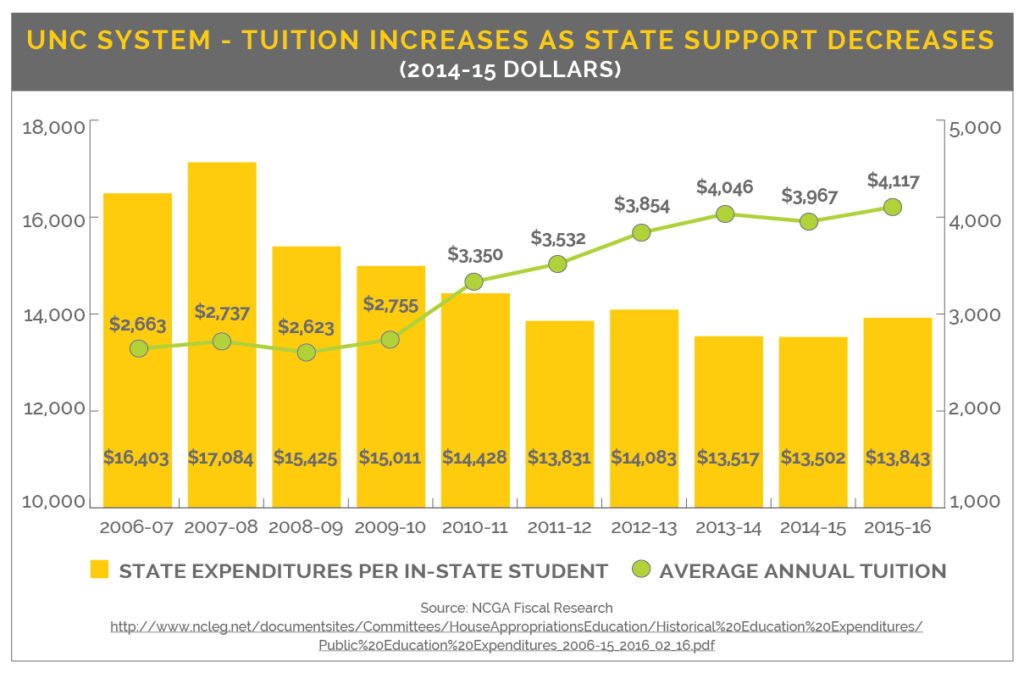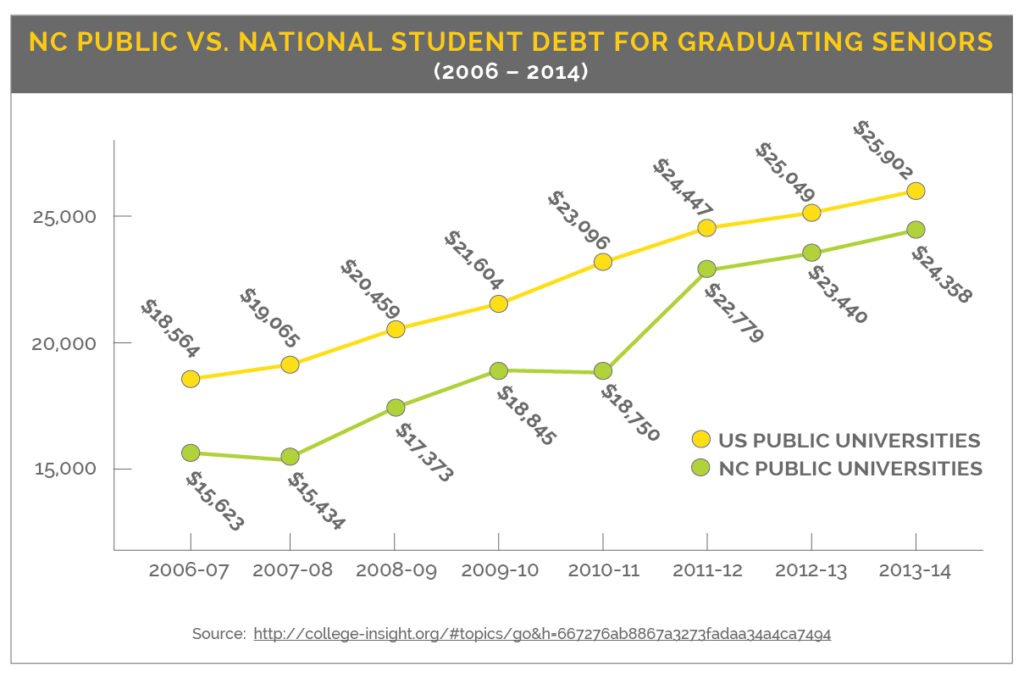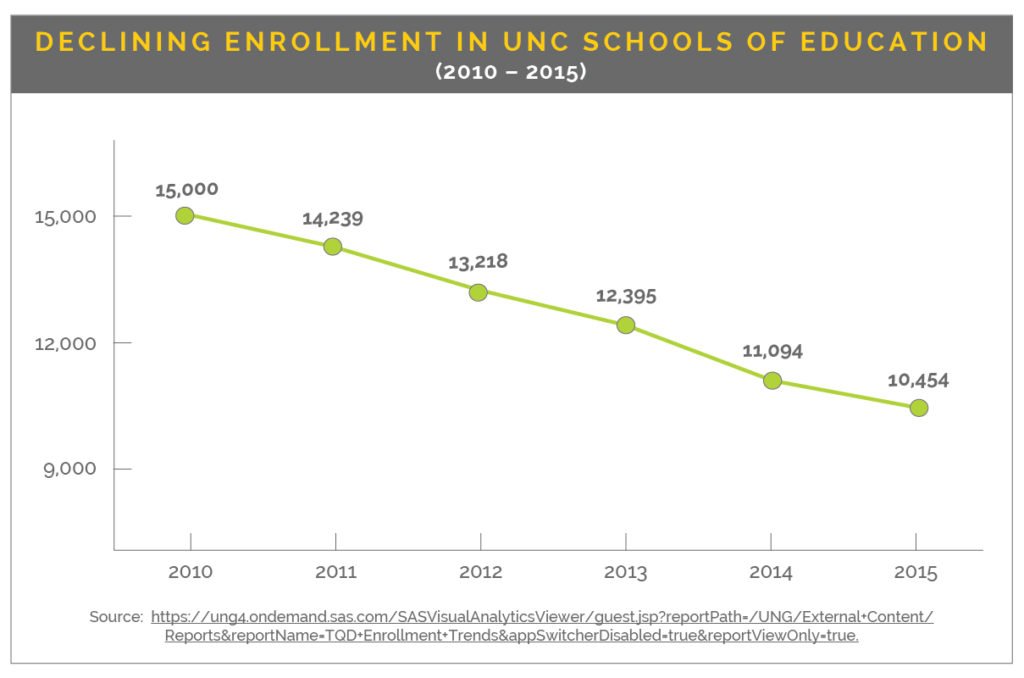RALEIGH – Continuing our look at North Carolina’s disinvestment in public education, a shortfall in state support has meant higher tuition and more debt for university students and fewer teachers for students in our K-12 public schools.
Though higher education is a public good that benefits us all – and our state constitution requires legislators to provide a college education for as close to free as possible1 – there’s no question the state has shifted part of the cost of higher education to students and their families.
Adjusted for inflation, state spending per in-state student at North Carolina’s public universities has declined $2,560, or 15.6%, since 2006-07.2 Over the same period, average tuition at our public universities rose 55%.3
Since 2008-09, when tuition at our state’s public universities accounted for 27% of the tuition/state appropriations mix, tuition has grown to account for 38%.
That change in percentages might not seem dramatic, but it means North Carolina students and their families collectively pay $378 million more for a public university education now than they did in 2008-09.4
North Carolina once prided itself on keeping tuition and, as a result, student debt low for its college graduates.
But for many students, the tuition increases of recent years mean more debt. From 2006-07 to 2013-14, average debt levels of graduating seniors in the UNC System rose 56%, from $15,623 to $24,358. And the debt levels of North Carolina public university graduates are now approaching the national average.
Student debt is also more widespread: The percentage of UNC System graduates who borrow has grown from 50% in 2009-10 to 62% in 2013-14.5
Those are dollars a young graduate might otherwise spend on a first car or home.
DISINVESTMENT in our K-12 public schools has consequences on university campuses as well.
As North Carolina’s rank in average teacher pay sank as low as 47th in the nation,6 enrollment in UNC System schools of education fell more than 30% from 2010-20157 – even as North Carolina’s population continued to grow and made it the 9th most-populous state.
UNC campuses supply 37.5% of the state’s public school teachers and 44 percent of its beginning teachers,8 so the decline in enrollment in teacher-prep programs foreshadows a shortage of teachers in North Carolina.
To their credit, state legislators have acted to raise teacher pay – particularly for beginning teachers – the past three years.9
But we can’t stop here. Our students – and our state’s economy – deserve more.
1 http://www.ncga.state.nc.us/Legislation/constitution/ncconstitution.html, Article IX, Section 9.
2http://www.ncleg.net/documentsites/Committees/HouseAppropriationsEducation/Historical%20Education%20Expenditures/Public%20Education%20Expenditures_2006-15_2016_02_16.pdf; https://www.bls.gov/data/inflation_calculator.htm.
3 UNC General Administration; https://www.northcarolina.edu/infocenter; https://www.bls.gov/data/inflation_calculator.htm.
4 Ibid.
5 http://college-insight.org/#topics/go&h=667276ab8867a3273fadaa34a4ca7494.
6 http://www.higheredworks.org/2017/05/nc-education-spending/.
7 https://ung4.ondemand.sas.com/SASVisualAnalyticsViewer/guest.jsp?reportPath=/UNG/External+Content/Reports&reportName=TQD+Enrollment+Trends&appSwitcherDisabled=true&reportViewOnly=true.
8 https://ung4.ondemand.sas.com/SASVisualAnalyticsViewer/guest.jsp?appSwitcherDisabled=true&reportViewOnly=true&reportPath=/UNG/External%20Content/Reports&reportName=NCTeachers.
9 http://www.higheredworks.org/2017/05/nc-education-spending/.




F. Harvey Pons, Jr. says
I have always stated “Education is not cheap, but ignorance is expensive”. I taught in North Carolina over 15 years, and I learned more by teaching than I did in the universities. Everyone should have to teach before they badmouth education.
paula says
This is shameful. Where are the proceeds from the NC Education Lottery going?